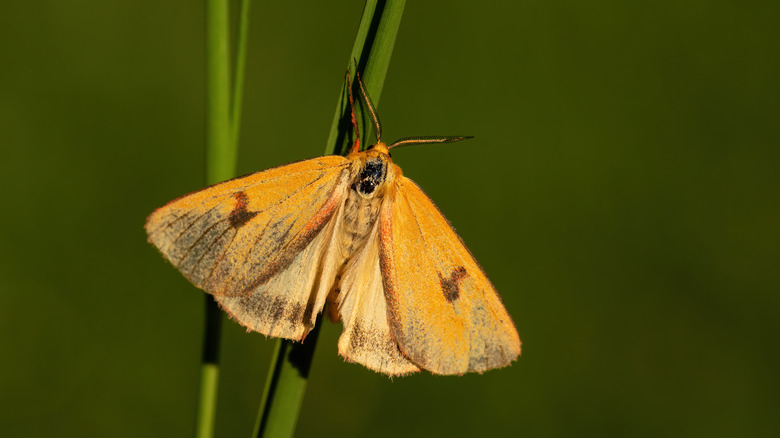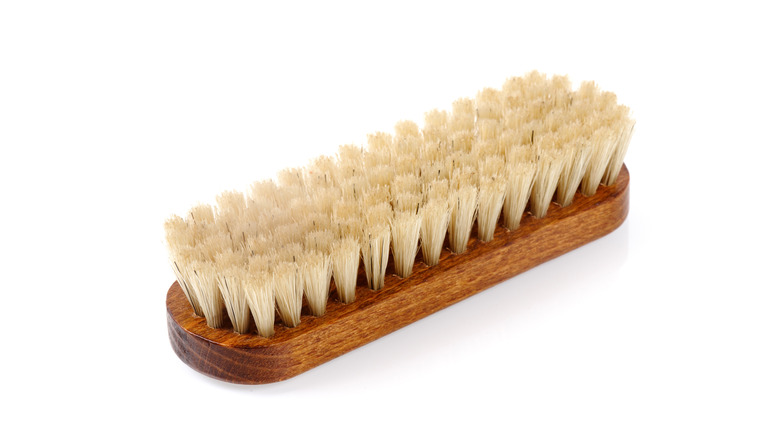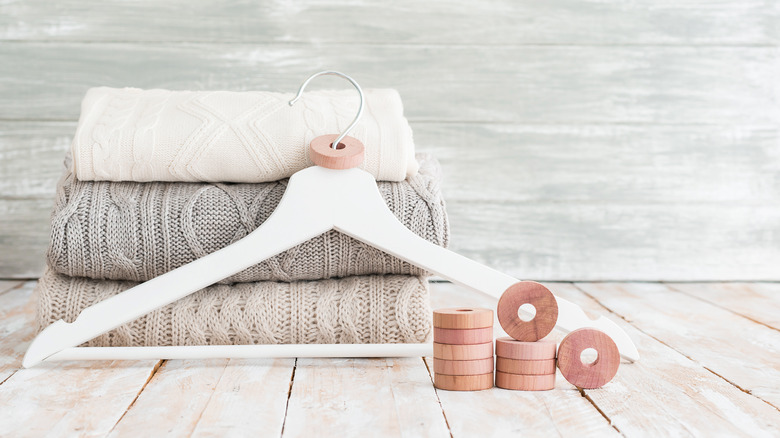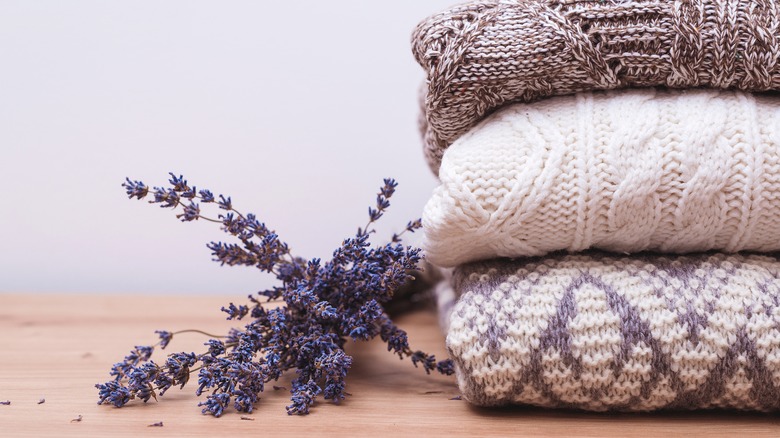Here's What You Need To Know About Mothproofing Your Clothing
We may receive a commission on purchases made from links.
Although they may seem harmless, moths are known for the extensive destruction they can cause to the interior of your home. Butterfly Conservation explains that moths look very similar to butterflies, and both insects are part of the Lepidoptera order due to their scaly wings. While butterflies thrive in the sunshine, moths prefer the darkness explains Smithsonian. Moreover, moths tend to display duller and more neutral wing colors.
Plunkett's Pest Control states that when moths enter your home, they are naturally attracted to the darkest areas, which tend to be your closets. The moisture and clothing inside also makes the perfect breeding ground for moth larvae. Moths will lay their eggs in the folds of clothes, which will then hatch and feed on the material as it transitions into an adult and repeats the entire process. Luckily, there are plenty of ways to prevent or stop the cycle from occurring or repeating. If you think you may have moths living inside your closet, there are a few simple steps you should take to free your closet from these destructive, clothing-eating pests.
Identifying the enemy
If you haven't physically seen any moths fluttering around your closet, how would you know that moths are actually causing destruction? The Smithsonian notes that there are a variety of pests, other than moths, that also enjoy feeding on clothing and other textiles. In fact, out of the hundreds of species of moth that exist, the Wirecutter states that there are only two species that actually eat clothing. Furthermore, you are actually lucky if the pests causing the destruction are not moths because other textile-eating insects are also much easier to eradicate.
To identify what is causing your closet's destruction, you first will need to properly identify the pest. Wirecutter claims that the two types of moths that feed on clothing and textiles are the casemaking clothes moths (tinea pellionella) and the webbing clothes moths (tineola bisselliella). Both of these moths have a body size of around 1/4 inch, with a doubled wing span of 1/2 inch. They are, however, better identified by their yellow body and fuzzy golden wings (per Michigan State University). Once you have identified these creatures, you can confidently continue with your moth extermination and prevention process.
Brush clothing
After correctly identifying the moths, your next step should be to exterminate them. Because the moths are using your clothes as a nest and food source for their larvae, the focus will be on your clothes.
Forbes mentions that simply taking your clothes out of your closet and exposing them to sunlight — or any type of bright light — will kill any larvae that may be attached, causing them to simply fall off your clothes. A clothing brush is also a useful tool when ridding your clothes of moths. Although any kind of clothing brush can work, Forbes mentions that horsehair or boars' hair brushes with wooden handles work the best. Ensure you thoroughly brush all your clothes, not forgetting to pay particular attention to the seams, folds, and pockets. Doing so will remove and kill the larvae, and discontinue the cycle of life the moths began inside your closet.
Basic closet cleaning
Moths thrive in old and musty surroundings, particularly with clothes that have been packed away or are very rarely used. They are never caught infesting frequently used or cleaned clothes or areas. This is why Martha Stewart highly recommends keeping your closets, along with other rarely touched areas of your home, well maintained.
Martha Stewart recommends starting with a simple vacuuming routine. Vacuuming proves to have the best results when done on a daily basis. Although quickly swinging your vacuum around the area may not seem very effective, it does more than you think in regards to moths. Without even realizing it, you can be getting rid of and killing moth larvae before it has the opportunity to hatch.
Tending to clothes before placing them into storage is another important task. According to Martha Stewart, this process involves paying a little extra money for dry cleaning your clothes and other textile objects before putting them in storage. Every once in a while, it may also be a good idea to expose your stored clothes to direct sunlight and even brush them out thoroughly before repacking them.
Moth control products
Good Housekeeping mentions that there are a variety of products you can invest in for easy removal and prevention of moths. Aromatic moth rings, made from all-natural cedar wood, can be placed among your clothes to keep moths away while freshening up the area with their scent.
Acana Moth Killer and Freshener is another highly recommended product. Similar to moth rings, this moth killer and fresher keeps moths away from your clothing and emits a lavender scent. Unlike the moth rings, however, this product thoroughly ensures the moths are killed and don't snack on your clothes again.
Other than products that directly affect the moths, Good Housekeeping also recommends products that simply protect your clothes and other valuables from hungry moths. For example, vacuum storage bags can keep your clothing tightly concealed and untouchable by moths. These bags are also useful for reducing bulk within a small or overpacked space.
Fragrances
Along with physical products you can purchase and place inside the moth-prone spaces inside your home, there are also various invisible barrier techniques you can also utilize to keep moths away. For example, Total Wardrobe Care states that fragrances are a great way to detract moths from any given area. This helps you protect your clothes without the use of chemicals or any other harmful substances.
Total Wardrobe further explains that during the time of the ancient Greeks and Romans, lavender and a variety of other herbs were commonly used to prevent moths from eating textiles that were stored for shipment. Keeping this in mind, filling your closet with a variety of herbal scents can work similarly to keep moths out of the area, while also generally freshening up the area. Some of the best and most recommended scents include may chang, lavender, cedarwood, patchouli, laurel, rosemary, thyme, and clove.





